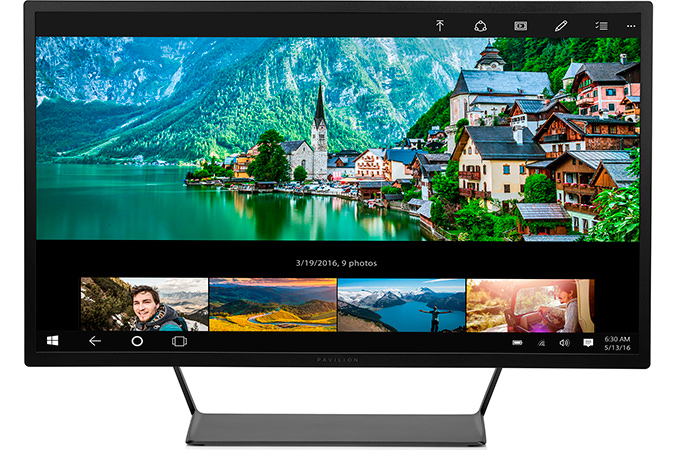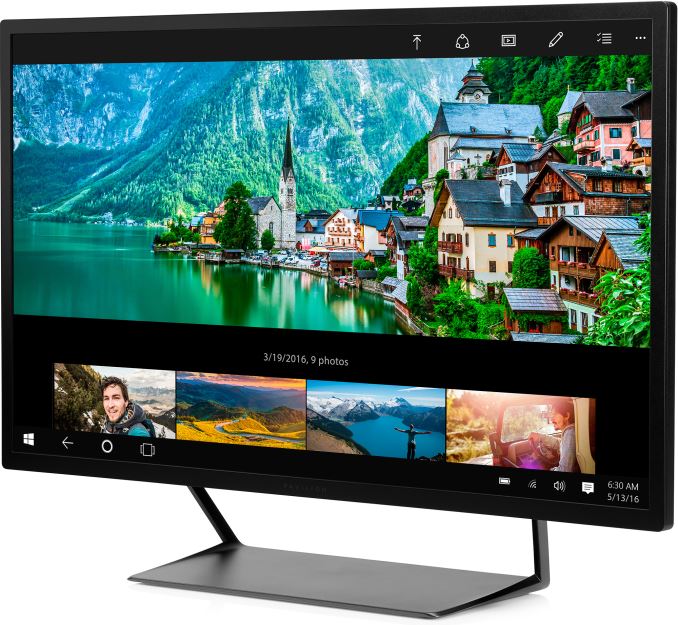HP Announces 32” Pavilion Display for Everyone: QHD for $399
by Anton Shilov on May 4, 2016 11:05 AM EST
HP has introduced its Pavilion 32 display (V1M69A), which promises to combine large size, QHD resolution, VA panel and affordability. The Pavilion 32 monitor may not appeal to professionals or hardcore gamers, but for mainstream users this one could be a game changer because of its price-point. The monitor will hit the market late next month as a part of HP’s back-to-school product refresh.
Modern day desktop workloads involve a lot of multitasking as well as long documents, large spreadsheets and high-resolution images. For many tasks, big displays are not a luxury, but rather a necessity. However, it is not easy to find a monitor that boasts with a large size, a good quality panel and an affordable price. There are relatively inexpensive 24” and 27” monitors with IPS or VA panels available, but when it comes to models with diagonals like 30” and larger, then it is not easy to find a good quality affordable display. While there are low-priced 32” monitors from unknown brands, they usually feature cheap TN panels and can hardly boast with good quality. Meanwhile, well-known suppliers charge $500 and up for their 32” models, which is more than many people are willing to spend on a display. With its Pavilion 32, HP wants to address the market of affordable monitors with an offering that is currently not available from its rivals.
The HP Pavilion 32 (V1M69A) display uses a 32" WVA+ panel with 2560×1440 resolution, 300 cd/m2 brightness, 3000:1 static contrast ratio, 178°/178° horizontal/vertical viewing angles as well as 60 Hz refresh rate. WVA stands for wide viewing angle, which is a general term to describe various types of panels (including *VA and PLS) used by display makers in their products. HP does not disclose exact type of the panel that powers the Pavilion 32”, but confirms that this is a VA panel (though, we have no idea whether this is AH-VA, A-MVA, etc.), not a TN (which is typically used for low-cost displays). In many ways, the Pavilion 32 resembles the Envy 32 monitor, which HP introduced several months ago. The Envy 32 has a similar WVA+ panel, but features stereo speakers as well as AMD’s FreeSync to appeal to gamers, but it is also more expensive.
| Specifications of HP Pavilion 32 and HP Envy 32 | ||||
| HP Pavilion 32 V1M69A |
HP Envy 32 N9C43AA |
|||
| Panel | 32" WVA+ | 32" WVA+ with Anti-Glare | ||
| Resolution | 2560 × 1440 | |||
| Refresh Rate | 60 Hz | 60 Hz with AMD FreeSync | ||
| Response Time | 7 ms gray-to-gray | |||
| Brightness | 300 cd/m² | |||
| Contrast | 3000:1 | |||
| Viewing Angles | 178°/178° horizontal/vertical | |||
| Color Saturation | 100% sRGB | |||
| Pixel Pitch | 0.276 mm | |||
| Pixel Density | 91.8 pixels per inch | |||
| Inputs | 2 × HDMI 1 × DP 1.2 |
1 × HDMI 1 × MHL 1 × DP 1.2 3.5 mm stereo-in |
||
| USB Hub | 2-port USB 2.0 hub | |||
| Audio | None | Stereo speakers with Bang & Olufsen enhancements |
||
| Launch Price | $399.99 | $499.99 | ||
The new Pavilion 32 display from HP is equipped with two HDMI and one DisplayPort 1.2 connectors (cables are included in the package). In addition, it has an integrated USB 2.0 hub, which should be enough to connect a keyboard, but which will not be sufficient for modern external USB flash memory drives that support USB 3.0 transfer rates. Keeping in mind that the hub is located on the backside of the monitor, it looks like it was not intended for removable storage in general. The design of the Pavilion 32 allows adjusting tilt, but not height. Asides from that, the monitor cannot be used in portrait mode, which is hardly a problem for the vast majority of its potential buyers.
Select retailers as well as HP’s online store will start to sell the HP Pavilion 32 on June 26 for $399.99. The monitor is covered by a one- or three year-limited warranty.
The key selling points of the HP Pavilion 32 are its relatively low price as well as its VA panel. Right now, the majority of 32” displays with QHD resolution from well-known suppliers cost over $500. By making its product available for $400, HP appeals to a broader audience of users, who currently buy smaller monitors. What remains to be seen is whether other display makers follow HP with their inexpensive 30” QHD parts.
Source: HP











74 Comments
View All Comments
Wolfpup - Wednesday, May 4, 2016 - link
This looks pretty nice. I've always liked VA, but am a gigantic fan now that I've seen how TERRIBLE IPS is on a TV. I didn't realize how massively better VA's contrast is than IPS. I guess it's not something you notice on a phone or something, but on a TV (and I'm sure it would apply to monitors as well)...night and day. Try watching Lucifer on an IPS TV :-O VA there's piles of color and contrast in all those dark colors. IPS it's just a smeary black mess.Eiffel - Wednesday, May 4, 2016 - link
This new monitor seems similar to the BenQ BL3200PT I'm currently looking at (the BenQ is slightly more expensive but has a USB3 hub, a card reader, a set of speakers, VGA/DVI/HDMI/DP inputs and a few additional features).The pixel pitch is basically the same as the one of 1980x1200 24" monitors... good enough for some of the latest Eizo CG series at over £1000. Assuming this HP product is as good as the BenQ, it is a valid product in today's world.
euskalzabe - Thursday, May 12, 2016 - link
Yup, this is the one regret I have about purchasing my LG instead of a Vizio. Colors look great in lighter images, but in dark ones the contrast goes out the window, and holy hell did somebody say backlight bleed?I can't wait until HDR TVs are available for around $600, the LG will be demoted to secondary TV and the HDR will be come the main. Hopefully a VA panel with local dimming and P3 colors!
rocky12345 - Wednesday, May 4, 2016 - link
I would luv a 27-30 2560x1600 16:10 screen much better than the 16:9 format. Well not much but it is nice having that little bit of extra height in the screen for sure. My projector is 16:10 & I can assure you the extra pixel height is much better for gaming. I really notice the 16:9 make it seem like squishy view when I watch a TV show that is 16:9 format. So if they could come out with a 16:10 Panel with current gen screen tech & a handy price like this HP unit I would be all over it for sure.pixelstuff - Wednesday, May 4, 2016 - link
Whatever happened to all of those fancy touch screen desktop monitors that Windows 8 (and now Windows 10) was supposed to inspire with elaborate desktop stands that allowed it to pull down flat when needed? Aka the stand-alone monitor version of the Lenovo A720 Desktop all-in-one.Lolimaster - Thursday, May 5, 2016 - link
Because they realize that even if its shown on sci-fi movies, touchscreen on big screens are annoying when its more comfortable to use a mouse/keyboard type of pshchical input.euskalzabe - Thursday, May 12, 2016 - link
Not necessarily. I still have and use my Dell ST2220T and use the touch functionality every now and then. It's perfectly comfortable as a complement to my mouse and keyboard.bznotins - Wednesday, May 4, 2016 - link
Still rocking my Dell 3007WFP from 10 years ago. Best $1100 I have ever spent on computers. Bridged many PC upgrade cycles. No internal display conversion hardware and thus no input lag.Would love to get a 4K equivalent. Feels like the market is getting there. But this HP isn't it.
DanNeely - Thursday, May 5, 2016 - link
I've got a similar era NEC 3090. Still looks great and my biggest future proofing concern is that the lack of a displayport input might bite me for $70ish in the future (the cheaper adapters top out at 1920x1200). It's possible I might end up with an ~32" 4k display at some point in the future; but what I'm really lusting after is the 31.5" 5k panel LG's been working on for the last year and change (almost as tall as my 1600p panel and at 186dpi 2:1 fallback scaling is more reasonable). It initially leaked in January with an expected release at the end of last year; it's slipped since then with TFT Central's panel database now calling for availability in the middle of this year. OTOH until this years GPUs launch gaming at 5k's more theoretical than a practical option.The_Assimilator - Thursday, May 5, 2016 - link
It's good that 2560x1440 is becoming more prevalent after so many years of stagnation at 1920x1080, but really 4K should be the standard at anything above 27".